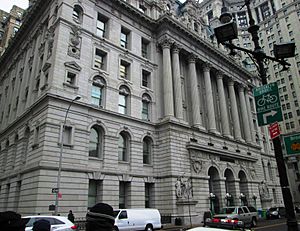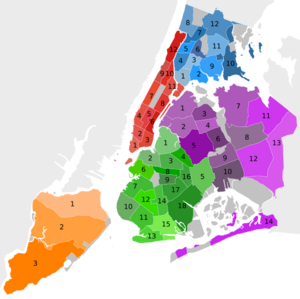Government of New York City facts for kids
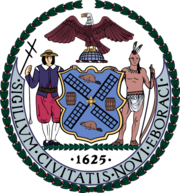
|
|
| Formation | December 16, 1665 |
|---|---|
| City charter | New York City Charter |
| City-wide elected officials | |
| Public Advocate | New York City Public Advocate |
| Comptroller | New York City Comptroller |
| Legislative branch | |
| Legislature | New York City Council |
| Meeting place | New York City Hall |
| Executive branch | |
| Mayor | New York City Mayor |
| Appointer | Election |
| Departments | See List of New York City agencies |
| Judicial branch | |
| Seat | New York City Hall |
The government of New York City helps run the city and keep things organized. Its main office is at New York City Hall in Lower Manhattan. The way it works is set up by the New York City Charter, which creates a system with a mayor and a city council.
The mayor is chosen by voters for a four-year term. They are in charge of managing how the city government works every day. The New York City Council is a single group of 51 members. Each member is elected from a specific area of the city, usually for four-year terms. When people vote for local leaders, they use a system called ranked choice voting in primary elections. For general elections, they use plurality voting, where the person with the most votes wins. All elected officials can only serve two terms in a row. The city also has a court system with different types of courts.
New York City's government is very big, with about 330,000 employees. This is more than any other city in the United States. It's even more than most U.S. states! The city government handles many important services. These include public schools, jails, police and fire departments, parks, trash collection, water supply, and help for families in need.
New York City is made up of five main areas, called boroughs. Each borough is also a county in New York State. For example, Brooklyn is Kings County, and Manhattan is New York County. When New York City became one big city in 1898, all the smaller local governments were replaced. This created the five boroughs and one main city government. However, each county still has its own district attorney to handle crimes. Most of the court system is also set up by county. Because of this, New York City is unique. It's not just one city or one county; it's a special kind of government structure. Each borough also has an elected Borough President, but their job is mostly about representing the borough and giving advice.
New York City is also part of two different federal court areas. Bronx County and New York County are in one area, while Brooklyn, Queens, and Staten Island are in another.
Contents
How the City Government Works
The New York City government has different parts that work together. These include the Mayor, the City Council, and various departments and offices.
The Mayor's Office
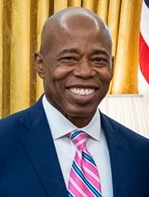
The Mayor is like the chief manager of the city. They are in charge of all the city's operations. The mayor can choose and remove many city officials. They are responsible for making sure the city government runs well and honestly. People vote directly for the mayor, who serves a four-year term. The mayor also creates the city's budget, which is then sent to the City Council for approval.
Other Citywide Leaders
Besides the mayor, two other officials are elected by all the people in New York City: the Public Advocate and the Comptroller.
The Public Advocate
The Public Advocate is an elected official who helps connect people with the government. They look into complaints about city agencies and help solve problems between city offices and citizens. They also give advice to the mayor on how to work with communities. The Public Advocate is also a member of the City Council. If the mayor can't do their job, the Public Advocate is the first person to take over.
The Comptroller
The Comptroller checks how city agencies are performing and how they spend money. They also manage the city's large retirement funds, which are worth billions of dollars. The Comptroller keeps an eye on the city's budget and financial health. They review city contracts to make sure they are fair and follow rules. They also handle claims made against the city. The Comptroller is second in line to take over if the mayor cannot serve, after the Public Advocate.
Independent City Offices
There are also many other groups, boards, and offices that work for the city but are not directly controlled by the mayor's office.
The City Council: Making Laws
The New York City Council is the part of the government that makes laws for New York City. The state constitution allows local governments to create their own laws, in addition to other rules and regulations.
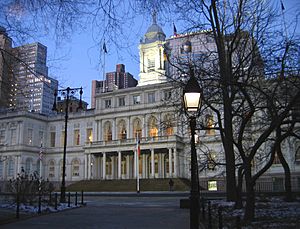
The Council has 51 members. Each member represents a specific area of the city with about 157,000 people. Council members are usually elected every four years. However, after a census (which happens every ten years), the district lines are redrawn. This means there will be two shorter terms of two years each. The Speaker of the Council is chosen by the 51 Council members. This person is often seen as the second most powerful person in New York City's government, after the Mayor.
When the Council passes a bill (a proposed law) with a simple majority vote, it goes to the mayor. The mayor can sign it into law. If the mayor doesn't agree and vetoes the bill, the Council has 30 days to vote again. If two-thirds of the Council members vote for the bill, they can override the mayor's veto, and the bill becomes law. These local laws are very important and are collected in a book called the New York City Administrative Code.
The Council has many committees that look closely at different parts of the city government. Every Council member is part of at least three committees. These committees meet at least once a month. The Speaker, the Majority Leader, and the Minority Leader are automatically members of every committee.
City Courts
New York City has a court system that includes two citywide courts and several statewide courts. Unlike other parts of New York State, New York City counties do not have a typical County Court. Each statewide court is located in each of New York City's five counties (boroughs). There are also other administrative courts that handle specific issues for city agencies.
The Criminal Court handles tickets, minor offenses, and less serious crimes (called misdemeanors). It also holds initial hearings for more serious crimes (called felonies).
The Civil Court handles cases about money, property, and agreements. This includes Housing Court for landlord-tenant issues and Small Claims Court for smaller money disputes (up to $5000). This court handles a large number of cases in New York State. There are also administrative courts, like the Office of Administrative Trials and Hearings (OATH), which settles disputes for city agencies. The city's Parking Violations Bureau handles parking tickets.
The Supreme Court is the main trial court for serious cases. In New York City, it hears felony cases and major civil cases. Less serious cases go to the Criminal Court and Civil Court. The Family Court handles cases involving children and families. The Surrogate's Court deals with wills and managing the property of people who have passed away.
Borough and Community Groups
New York City is made up of five boroughs, which are divided into 59 community districts.
Borough Presidents
Each of the five boroughs has an elected borough president. Borough presidents can suggest new laws to the City Council. They can also recommend big building projects and hold public meetings on important topics. They give advice to the mayor and other city officials, especially about land use and planning. They also make suggestions about how well city services are being delivered in their borough.
Borough Boards
Each of the five boroughs also has a borough board. These boards include the borough president, the City Council members from that borough, and the head of each community board in the borough. Borough boards can hold meetings, create plans for land use, and help solve disagreements between community boards. They also suggest what the borough needs for its budget and check how well city services are working.
Community Boards
Each of the 59 community districts has a community board. These boards have up to 50 volunteer members. They are chosen by the local borough president, with half of them nominated by City Council members. Community boards give advice on land use and zoning rules. They also take part in the city's budget process and help address service issues in their area. Community boards offer advice, but they don't have the power to make or enforce laws themselves.
State and County Government in NYC
District Attorneys
Each of New York City's five counties elects a district attorney (DA) for a four-year term. Their job is to bring legal cases against people accused of crimes in their county. There is also a sixth DA, the Office of the Special Prosecutor for Narcotics. This person is not elected but is appointed by the five elected DAs.
Public Organizations

The Brooklyn Public Library and Queens Public Library serve their boroughs. The New York Public Library is a private organization that serves the Bronx, Manhattan, and Staten Island, but it also gets money from the government. The New York City Housing Authority (NYCHA) provides public housing for people with lower incomes. NYC Health + Hospitals runs public hospitals and clinics. The New York City Economic Development Corporation (NYCEDC) works to help the city's economy grow.
The Metropolitan Transportation Authority (MTA) runs the New York City Subway and the city buses through its group, the New York City Transit Authority. Even though it has "New York City" in its name, the MTA was actually created by the state government. The MTA also runs the Staten Island Railway and commuter trains like the Long Island Rail Road and Metro-North Railroad. These trains start in the city but mostly run to areas outside of it.
Other transportation in the region is managed by the Port Authority of New York and New Jersey. This includes bridges and tunnels between New York City and New Jersey, and all airports and seaports in the city. The Port Authority is a special group controlled by both the Governor of New Jersey and the Governor of New York.
City Symbols
The seal of New York City was first used a long time ago in 1686. It has a Latin phrase that simply means "The Seal of the City of New York." The two figures on the seal show the friendship between Native Americans and early settlers. The four windmill sails remind us of the city's Dutch past, when it was called New Amsterdam. The beavers and flour barrels represent the city's first important trade goods. The American eagle was added after the American Revolution. The date "1625" at the bottom was chosen to highlight the city's Dutch history, but some historians say the city was actually settled in 1624.
The flag of New York City was adopted in 1915. Its blue, white, and orange stripes are the same colors as the Dutch flag that flew over New Amsterdam from the 1620s to the 1660s. In the middle of the flag is a blue picture of the official Seal of New York City, but without its Latin motto.
There are two official versions of the New York City flag. The Mayor's Office flag has an arc of five blue stars above the seal, representing the five boroughs. The City Council's flag adds the word "COUNCIL" in blue below the seal.
See also
 In Spanish: Gobierno de la Ciudad de Nueva York para niños
In Spanish: Gobierno de la Ciudad de Nueva York para niños
- Government and politics in Brooklyn
- Government of New York (state)
- List of New York City borough halls and municipal buildings
- Politics of New York City


